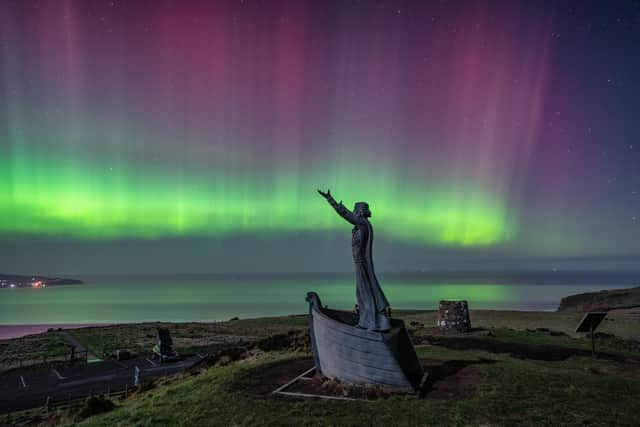Northern Lights: Will aurora borealis be visible in UK tonight? Weather forecast and best time to see them
and live on Freeview channel 276
It seems to have been a busy start to the week for our nearest star, with the Sun reportedly throwing out solar flares and a "cannibal" coronal mass ejection (CME).
On Monday (17 July), Russian scientists warned of strong solar flare activity that could interfere with short-wave communications, after three flares were seen on the Sun the previous day. And now, multiple solar storms and a "dark eruption" have caused a rare "cannibal" gas ejection that could cause geomagnetic storms on Earth.
Advertisement
Hide AdAdvertisement
Hide AdWhen the strong magnetic fields inside and around the sun rejoin, solar flares occur. According to NASA, they have the ability to interfere with Earth's magnetic field and harm satellites and communication technology.
But heightened solar activity also has the chance of bringing a more picturesque phenomenon to stargazers alongside the potential for logistical and technological nightmares - the aurora borealis, or 'Northern Lights'.
Auroras usually occur in a band called the annulus (a ring about 1,865 miles across) centred on the magnetic poles. Seeing the aurora borealis is usually something people travel to the most northern parts of the world to see, like Iceland and Norway.
But the arrival of a coronal mass ejection from the sun can cause the annulus to expand, bringing the aurora to lower latitudes. It is under these circumstances that the lights can be seen in the UK. Though the aurora borealis is active year-round, its strength can be increased by solar activity at any time.
Advertisement
Hide AdAdvertisement
Hide Ad

What's happening with the Sun?
Russia's Fedorov Institute reported that three solar flares were seen on Sunday (16 July), with one lasting 14 minutes and interfering with radio communication. Now, multiple solar storms and a "dark eruption" have reportedly caused a rare "cannibal" gas ejection that could cause geomagnetic storms on Earth.
This expulsion of energetic and highly magnetised gas was released four days ago, and is currently on a collision course with our planet. Given its relative rarity, it is less familiar to scientists than usual CMEs.
There are fears the CME, which formed from several solar storms and a unique "dark eruption" (so-called because the solar flare's cool plasma gives it the appearance of being darker than the sun's surface), will cause a mild geomagnetic storm when it collides with Earth on 18 July.
Will the Northern Lights be visible in the UK?
The Met Office has said the aurora may be visible in parts of the country this week as a result of the solar activity. "A CME may give Earth a glancing blow during the daylight hours of the 20th," it says, "giving a reasonable confidence of aurora sightings across the whole of Scotland, Northern Ireland and parts of northern England where skies are clear.
Advertisement
Hide AdAdvertisement
Hide Ad"However viewing opportunities are expected to be limited due to short hours of darkness at this time of year."
AuroraWatch UK is not predicting any significant aurora for the evening of 18 July, but in line with the Met Office's predictions, this could change later in the week.
How can I see the Northern Lights?
The northern lights, also known as aurora borealis, are a natural light display caused by charged particles from the sun colliding with the Earth’s atmosphere. When these charged particles collide with the gases in our atmosphere, such as oxygen and nitrogen, they release energy in the form of light.
You are more likely to get a good sighting around midnight, and of course you’ll need a clear sky for the best. It’s also best to avoid nights when there is a full moon, as the light from the Moon can dampen the aurora’s effect.
Advertisement
Hide AdAdvertisement
Hide AdIt might seem obvious, but you’ll need to look north to see them - the lights emanate from the north, so turn in that direction. Ideally, you’ll want a low horizon unobscured by buildings or geographical features like hills.
Try to get as far away from the light pollution of towns and cities as you can, and make sure you keep an eye out for unusual light patterns in the sky. Sometimes it can look like a slight flicker of colour, other times you will have no doubt it’s the auroras.
Check the weather forecast and keep an eye on websites like AuroraWatch UK which can help you identify peak times for viewing.
The most spectacular pictures of the aurora borealis are usually captured with a long-exposure, which leads many people to expect the brilliantly green trails of light snaking eerily across the night sky. In actuality, the lights might look like a faint film of mist to the naked eye.
Using a long exposure to capture the aurora on camera necessitates the use of a tripod to keep your camera steady, but you can get some spectacular results when exposing for around 20-30 seconds.
Comment Guidelines
National World encourages reader discussion on our stories. User feedback, insights and back-and-forth exchanges add a rich layer of context to reporting. Please review our Community Guidelines before commenting.
